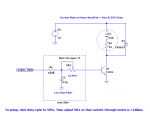Hi Jim,
What I mean by a Poor Man's DAC is a PWM applied to a low pass filter so that a DC voltage is produced that is proportional to the PWM duty cycle.
The pros are that it is cheap ( 1 or 2 caps and 1 or 2 resistors) and is simple to implement.
The main cons are that there is scant little current at the output so that most of the time the DC signal needs to be buffered with an OPAMP, and that there can be some response delay. This delay can be made negligible by using a relatively high PWM frequency along with careful component selection.
Do a search here for "low pass filter" and see what pops up. I'm fairly sure that I and others have posted some diagrams here.
What I mean by a Poor Man's DAC is a PWM applied to a low pass filter so that a DC voltage is produced that is proportional to the PWM duty cycle.
The pros are that it is cheap ( 1 or 2 caps and 1 or 2 resistors) and is simple to implement.
The main cons are that there is scant little current at the output so that most of the time the DC signal needs to be buffered with an OPAMP, and that there can be some response delay. This delay can be made negligible by using a relatively high PWM frequency along with careful component selection.
Do a search here for "low pass filter" and see what pops up. I'm fairly sure that I and others have posted some diagrams here.

